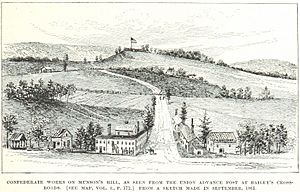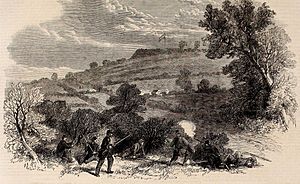Munson's Hill facts for kids
Munson's Hill is a small mountain, or "geographic eminence," located in eastern Fairfax County, Virginia. Its highest point is about 367 feet (112 meters) above sea level. This hill has a rich history, especially during the American Civil War, and is now an important commercial area.
Contents
Where is Munson's Hill and How Did it Get its Name?
Munson's Hill is found near Seven Corners, Virginia, where several busy roads like Leesburg Pike and U.S. Route 50 meet. It's right next to another hill called Upton's Hill. For a long time, people thought of this area as two separate hills, but geographers now see them as one.
The hill is part of a chain of hills that surround Washington, D.C.. Washington, D.C. itself sits in a natural "bowl" formed by these hills. Munson's Hill, along with Mason's Hill and Minor's Hill, helps form this natural boundary.
The hill is named after Daniel O. Munson. He moved to a large 180-acre farm on the hill in 1851. There, he started a big plant nursery called Munson Hill Nurseries, which operated for many years. Daniel and his father built a beautiful home on the hill. Sadly, this home was torn down in 1962 to build an apartment building, which is still there today.
In 1955, the very top of Munson's Hill was flattened by bulldozers. This was done to create more space for building houses. So, the hill you see today is a bit shorter than it used to be.
From Munson's Hill, you can look out over the wide, flat area known as Bailey's Crossroads. During the Civil War, soldiers and reporters often visited the hill. They loved the amazing view, which included much of Washington, D.C., and the surrounding areas. One reporter in 1861 described the view as "exquisite beauty," mentioning the distant river and the Capitol dome in Washington.
Munson's Hill During the Civil War
Munson's Hill became very famous during the American Civil War. It even made headlines around the world! After the war began, Union Army troops suffered a big loss at the First Battle of Bull Run in July 1861. This caused them to pull back from Northern Virginia.
Confederate Army soldiers quickly took over Munson's, Upton's, and Mason's hills. From these high points, they had a clear view of Bailey's Crossroads and could even see into the federal capital. People in Washington, D.C. could see a huge Confederate flag waving proudly from the top of Munson's Hill.
A tense standoff followed. People in Washington worried that the Confederates would attack from Falls Church and these hills. Observers at the U.S. Capitol used telescopes to see what looked like scary Confederate cannons on Munson's Hill. The nearby village of Falls Church, Virginia was the local Confederate headquarters.
This area became very dangerous. Confederate sharpshooters, with their excellent view of Bailey's Crossroads, Virginia, would shoot Union soldiers. During one intense fight near the Munson home, Daniel Munson tried to escape on his horse. As he rode out, Confederate sharpshooters shot his horse! Daniel quickly got up and ran across the fields to safety with the Union Army.
Everything changed on the night of September 28, 1861. The Confederate Army quietly left Falls Church and Munson's, Mason's, and Upton's hills. They moved back to Centreville, Virginia and built strong defenses there.
To the Union Army's great embarrassment, they discovered that the "fearsome-looking" cannons were actually "Quaker guns." These were just logs painted black to look like real cannons! The army was made fun of across the North. People wondered how their army had been held back for two months by nothing more than painted logs.
Songs were even written to make fun of the Northern generals. Titles like "The Bold Engineer" and "Munson's Hill!" poked fun at the situation. One song even called Munson's Hill a "mountain of sand."
Life was hard for the Munson family during this time. Daniel's elderly father, Timothy B. Munson, had to seek safety in Washington. After the Southern army left, he faced many difficulties under the Union Army's rule. Ironically, some of the worst problems came from soldiers from his own home state of New York. Timothy wrote a letter to a newspaper, listing all the problems. He ended with a plea: "My God! How long must these things continue? We may well exclaim, Save us from our friends!!!"
Many pictures, called lithographs, of Munson's Hill were published in newspapers in America and Britain during the early Civil War. Some showed Daniel Munson's large barn, and one showed his home. These pictures have been reprinted in a local history book about the Civil War.
Munson's Hill Today
After the Civil War, the Munson's Hill Nurseries recovered. They provided many plants and trees for Northern Virginia. In Falls Church, Daniel Munson planted beautiful silver maple trees along Broad Street in 1889. Sadly, many of these trees were cut down in the 1940s and 1950s to widen the streets.
Today, Falls Church still tries to plant many street trees, continuing the legacy of the beautiful trees Munson planted.
Munson's Hill was fully developed in the 1950s and early 1960s. Much of it is now part of the busy commercial and shopping area called Seven Corners, Virginia. This area has many large stores and shopping centers along Leesburg Pike. The slopes and former top of the hill are now covered with houses. Today, Munson's Hill is a very important business area.
Images for kids




